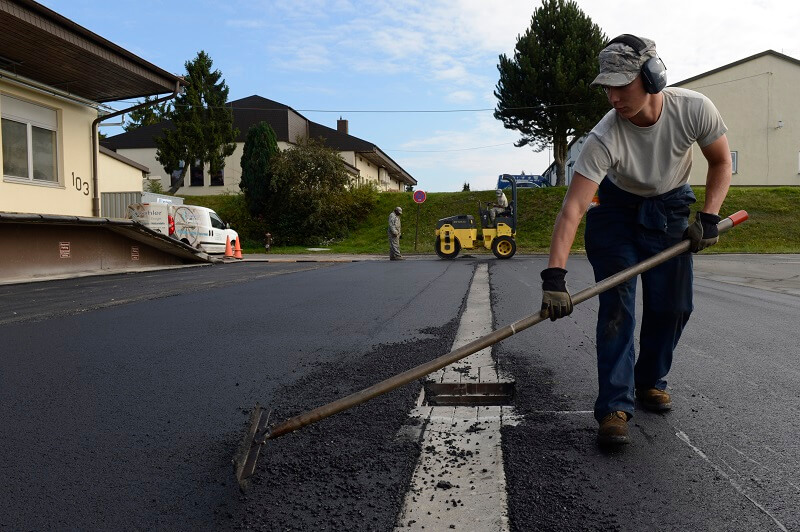Paving is all about creating a solid surface, whether it’s for a road, a driveway, or a parking lot. The goal is to lay down materials in a durable, safe, and visually appealing way. But what are the principles that guide this process? Understanding these principles can help you appreciate the craftsmanship that goes into paving and ensure you get the best results for your project.
Today, you will learn about the paving principles and how they work. Let’s dive into the details:
Importance of Consistent Paving Speed
One of the most important aspects of paving is maintaining a consistent speed. Imagine driving a car—if you speed up and slow down unpredictably, the ride becomes bumpy. The same principle applies to paving. If the paving equipment moves too fast or too slow, it can create uneven surfaces, which can lead to problems like cracking or potholes later on.
Consistent paving speed ensures that the asphalt or other materials are spread evenly. This helps the material adhere properly and form a smooth, long-lasting surface. It also helps in achieving a uniform thickness, which is crucial for the longevity and durability of the pavement.
Technology and Equipment Used in Asphalt Paving
Asphalt paving has come a long way thanks to advancements in technology and equipment. Modern paving involves specialized machinery that makes the process more efficient and precise. Here are a few key pieces of equipment used:
1. Pavers
These machines spread the asphalt evenly and compact it as it’s laid down. They come with various attachments to help control the thickness and smoothness of the asphalt.
2. Rollers
After the asphalt is laid down, rollers are used to compact it. This compaction is crucial for making sure the asphalt bonds well and creates a strong surface.
3. Milling Machines
These are used to remove old asphalt or other surface layers before new paving begins. This ensures that the new layer adheres properly to the existing surface.
4. Temperature Gauges
These monitor the temperature of the asphalt to make sure it’s within the optimal range for spreading and compaction.
Major Principles of Asphalt Paving
When it comes to asphalt paving, there are three major principles to keep in mind:
· Proper Preparation
Before laying down any asphalt, the base must be prepared properly. This means ensuring that the ground is properly graded and compacted. If the base isn’t stable, the asphalt can shift and crack over time. Good preparation also involves clearing debris, filling in low spots, and ensuring proper drainage.
· Correct Temperature
Asphalt needs to be at the right temperature when laid down. If it’s too hot, it can be too liquid and won’t set properly. It can become too stiff and difficult to work with if it’s too cold. The ideal temperature helps achieve the best compaction and smoothness.
· Compaction
As mentioned earlier, compacting the asphalt is essential. Proper compaction helps remove air pockets and ensures the asphalt is dense and strong. This prevents issues like cracking and deformation over time. Using the right equipment and techniques for compaction is key to a successful paving job.
What is the Best Paving Procedure?
So, what’s the best procedure for paving? Here’s a step-by-step guide to ensure your paving project turns out great:
Lay down a base layer of material, usually gravel or crushed stone. This provides a strong foundation for the asphalt and helps with drainage. Compact the base thoroughly. Heat the asphalt to the correct temperature and lay it down using a paver. Spread it evenly and make sure it’s at the right thickness. Smooth it out as you go to avoid any bumps or uneven spots.
Use rollers to compact the asphalt while it’s still warm. This step helps to remove any air pockets and ensures a solid surface. Once the asphalt is laid and compacted, make any necessary finishing touches. This might include adding striping or adjusting the edges. Allow the asphalt to cure properly. Avoid heavy traffic on the new surface for a few days to ensure it sets correctly.
Following these steps ensures that your paving project is done right, resulting in a smooth, durable surface that will last. Knowing about logistics and technologies helps you to pave easily and effortlessly. You will get top-notch services at the right stage for a successful project. Just plan according to the roads and type of material.
Conclusion
Remember the three major principles: proper preparation, temperature, and effective compaction. BY following a solid paving procedure, you can achieve a high-quality, functional, and aesthetically pleasing result. We hope this guide has helped you understand the basics of paving and what goes into creating a great paved surface. Feel free to reach out if you have any questions or need more information. At Standard Paving, we have professionals to answer your queries.
property for years.

